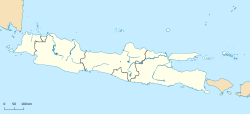| Amanjiwo | |
|---|---|
| | |
| General information | |
| Location | Magelang, Indonesia |
| Coordinates | 7°37′55″S110°12′9″E / 7.63194°S 110.20250°E |
| Opening | 1997 |
| Owner | Aman Resorts |
| Management | Aman Resorts |
| Design and construction | |
| Architect(s) | Ed Tuttle |
| Other information | |
| Number of suites | 36 |
Amanjiwo is a five star luxury hotel in the Menoreh Hills near Magelang, Central Java, Indonesia. It lies opposite the 9th century Buddhist sanctuary and UNESCO World Heritage Site, Borobudur. It is owned and operated by Aman Resorts and was opened on 16 October 1997. [1] The name "Amanjiwo" means "peaceful soul". [1]





